
Journal of Agromedicine
Scope & Guideline
Empowering researchers to tackle agromedicine challenges.
Introduction
Aims and Scopes
- Agricultural Health and Safety:
Research on health risks and safety practices among agricultural workers, including injury prevention, exposure assessments, and the impact of working conditions on health. - Mental Health in Agriculture:
Exploration of mental health issues within farming communities, including stressors, coping strategies, and interventions designed to promote mental well-being among farmers and farmworkers. - Occupational Health Risks:
Investigation of occupational exposures and health outcomes related to agriculture, including pesticide exposure, zoonotic diseases, and ergonomic risks. - Community Health and Resilience:
Studies focusing on the health of rural communities, particularly in relation to natural disasters, economic stress, and health disparities among agricultural workers. - Public Health Interventions:
Development and evaluation of public health initiatives aimed at improving health literacy, access to care, and safety education in agricultural populations. - Policy and Advocacy:
Research that informs policy decisions affecting agricultural health and safety, including labor rights, worker protection standards, and resource allocation.
Trending and Emerging
- Mental Health Interventions:
An increasing focus on mental health interventions for farmers and agricultural workers, driven by rising awareness of mental health challenges exacerbated by economic pressures and social isolation. - Impact of Climate Change on Health:
Research exploring the intersection of climate change and agricultural worker health, including studies on heat stress, respiratory issues from air quality, and the effects of extreme weather on farming communities. - COVID-19 and Agricultural Workers:
A significant emphasis on the impact of the COVID-19 pandemic on agricultural workers, including studies on health risks, vaccination efforts, and access to healthcare during the crisis. - Diversity and Inclusion in Agriculture:
An emerging focus on the health and safety issues faced by diverse populations within agriculture, including migrant workers and LGBTQ+ farmers, addressing unique vulnerabilities and health disparities. - Technological Innovations in Safety:
Exploration of how new technologies, such as wearable devices and mobile applications, can enhance safety practices and health monitoring among agricultural workers.
Declining or Waning
- Traditional Agricultural Practices:
Research related to conventional farming methods and their health impacts has seen a decline, potentially overshadowed by a growing focus on sustainability and innovative practices. - General Health Education:
Broader health education topics that do not specifically address agricultural contexts are being phased out in favor of more targeted interventions that consider the unique challenges faced by agricultural workers. - Child Safety in Agriculture:
While still relevant, studies specifically targeting child safety in agricultural settings are becoming less frequent, possibly due to shifting focus towards adult worker health and mental well-being. - Global Comparisons of Agricultural Health:
Comparative studies that lack a localized context or fail to address specific regional issues are becoming less common, as the journal emphasizes localized research that addresses community-specific challenges.
Similar Journals

International journal of Health Medicine and Current Research-IJHMCR
Championing open access for global health advancement.Welcome to the International Journal of Health Medicine and Current Research (IJHMCR), a pivotal platform dedicated to advancing knowledge in the fields of health, medicine, and current scientific research. Published by the esteemed INT JOURNAL HEALTH MEDICINE & CURRENT RESEARCH-IJHMCR in Indonesia, this journal aims to foster innovation and collaboration among researchers, professionals, and students alike. With a commitment to Open Access publishing, IJHMCR ensures that cutting-edge research is accessible to a global audience, promoting the exchange of ideas and enhancing the impact of healthcare and medical research. Our mission is to provide a forum for original research, reviews, and case studies that contribute to the understanding and improvement of health and medicine. We invite you to explore the high-quality articles and findings published within our pages, and to contribute your own insights to this growing body of knowledge.
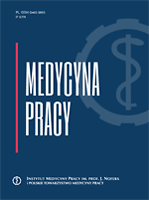
Medycyna Pracy-Workers Health and Safety
Empowering professionals to enhance workplace well-being.Medycyna Pracy - Workers Health and Safety is a distinguished open-access journal published by the NOFER Institute of Occupational Medicine in Poland, dedicated to advancing the field of occupational health and safety. Established in 1953, this journal has evolved to provide a vital platform for researchers, practitioners, and students to disseminate their findings and insights regarding worker health and well-being. With a Q3 ranking in both Medicine (miscellaneous) and Public Health, Environmental and Occupational Health categories, it reflects a commitment to high-quality scholarship despite its recent Scopus percentile (35th). The journal's rich history encompasses issues from 1953 to the present, allowing for a comprehensive examination of trends and developments in the field. Since adopting an open-access model in 2013, Medycyna Pracy has broadened its reach, ensuring that critical research is freely available to anyone seeking to enhance workplace safety and health outcomes. By fostering dialogue among multidisciplinary professionals, this journal aims to impact policy, practice, and education in occupational health, making it an essential resource for anyone engaged in this vital area of study.
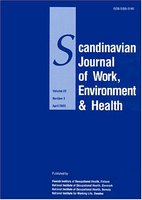
SCANDINAVIAN JOURNAL OF WORK ENVIRONMENT & HEALTH
Advancing workplace health through rigorous research.SCANDINAVIAN JOURNAL OF WORK ENVIRONMENT & HEALTH, published by the Scandinavian Journal Work Environment & Health, is a leading platform dedicated to advancing research in the fields of public health, environmental health, and occupational health. Established in 1975 and set to continuously evolve until 2024, this journal serves as a vital resource for scholars, practitioners, and policymakers concerned with workplace health and safety issues. Notably, it holds an impressive Q1 ranking in its category, and is positioned in the top 10% (90th percentile) of its field according to Scopus rankings, affirming its significance and impact within contemporary research. With a commitment to rigorous peer-review, the journal provides open access to cutting-edge studies, promoting knowledge dissemination and collaborative dialogue among professionals. As the landscape of work environments increasingly intersects with health outcomes, the SCANDINAVIAN JOURNAL OF WORK ENVIRONMENT & HEALTH remains an essential reference point for all those aiming to enhance workplace health criteria and public well-being.

Indian Journal of Occupational and Environmental Medicine
Elevating Standards in Occupational and Environmental MedicineIndian Journal of Occupational and Environmental Medicine, published by Wolters Kluwer Medknow Publications, is a pivotal resource in the field of public health, focusing on the critical intersections of occupational safety and environmental health. With the ISSN 0973-2284 and E-ISSN 1998-3670, this journal has been a beacon of knowledge since its inception in 1999 and continues to influence scholarly discourse through its convergence years culminating in 2024. Recognized for its contribution to the field with a 2023 Scopus categorization of Q3 in Public Health, Environmental and Occupational Health, it has secured its place among the top journals, ranked #453 out of 665 within its specialty, reflecting a respectable 31st percentile. While it operates on a subscription basis, the journal ensures comprehensive coverage of significant research, thereby enhancing occupational health practices and environmental health policies. It serves as a vital platform for researchers, professionals, and students dedicated to advancing knowledge and improving outcomes in these crucial areas of health. The journal's commitment to excellence is evident as it continues to cater to a diverse readership from its base in Mumbai, India.

Medicina del Lavoro
Elevating standards in public health and safety.Medicina del Lavoro, published by MATTIOLI 1885, is a distinguished academic journal that has been a pivotal resource for the fields of medicine and public health since its inception in 1947. With an ISSN of 0025-7818, this journal focuses on disseminating high-quality research relevant to environmental and occupational health, positioning itself in the Q2 category for both Medicine (miscellaneous) and Public Health, Environmental and Occupational Health. Its notable Scopus ranking places it within the top 69th percentile of its field, reflecting its commitment to scholarly excellence. While the journal is not open access, it offers a range of informative articles, including original research, reviews, and case studies, that are essential for researchers, professionals, and students committed to advancing their understanding of workplace health and safety. With articles converging up to 2024, Medicina del Lavoro continues to illuminate critical issues and foster discussion within the global health community.
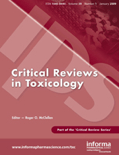
CRITICAL REVIEWS IN TOXICOLOGY
Pioneering Comprehensive Reviews in Toxicological SciencesCRITICAL REVIEWS IN TOXICOLOGY, published by Taylor & Francis Ltd, stands as a preeminent journal within the field of toxicology, boasting an impressive Q1 ranking and holding the distinction of being ranked 12th out of 133 in the toxicology category according to Scopus, placing it in the top 91st percentile. With a continuous publication history since 1971 and a commitment to providing high-quality reviews, the journal offers critical insight into the latest research and advancements in toxicological sciences. While it is not an open-access journal, it provides numerous access options for both subscribers and institutions, ensuring that its extensive articles are widely available to the academic community. The journal's objectives are to disseminate comprehensive reviews that foster understanding and innovation in the assessment of chemical risks, environmental impacts, and the mechanisms of toxicity, making it an invaluable resource for researchers, professionals, and students dedicated to the science of toxicology.
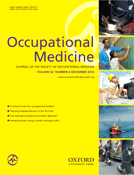
OCCUPATIONAL MEDICINE-OXFORD
Fostering Knowledge for Safer Workplaces WorldwideOccupational Medicine-Oxford is a leading journal in the fields of public health and occupational health, published by Oxford University Press. With an ISSN of 0962-7480 and an E-ISSN of 1471-8405, this esteemed journal has been disseminating critical research findings since its inception in 1948. Ranked in the Q2 category for both Medicine (miscellaneous) and Public Health, Environmental, and Occupational Health, it occupies a significant spot in the academic community, with a Scopus ranking of #147 out of 665 in its categories, placing it within the 77th percentile. The journal aims to enhance the understanding of occupational health issues and promote practices that improve worker safety and well-being. As a vital resource for researchers, professionals, and students alike, Occupational Medicine-Oxford provides insights into emerging trends, comprehensive reviews, and original research articles that pave the way for future innovations in occupational health strategies. Explore the journal for the latest developments in this critical field, and gain access to a wealth of knowledge that can make a meaningful impact on public health policies and occupational practices worldwide.
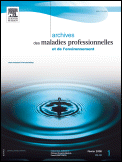
Archives des Maladies Professionnelles et de l Environnement
Championing Research that Shapes Policy and PracticeArchives des Maladies Professionnelles et de l'Environnement is a vital scholarly journal published by Elsevier Science Inc, focusing on the critical intersections of public health, environmental issues, and occupational health. With an ISSN of 1775-8785 and an E-ISSN of 1778-4190, this French-based journal serves as a platform for researchers, professionals, and students to explore contemporary challenges and advancements in these essential fields. Although it holds a Q4 ranking in the 2023 Scopus quartiles, it provides a unique opportunity for new contributions that can drive future research directions. The journal accepts a variety of article types, with the aim of spreading knowledge that can influence policy and improve practices in occupational health and environmental safety. As we approach the convergence of its publication years from 2004 to 2024, the journal remains committed to fostering a comprehensive understanding of the impact of work and environmental exposure on health, making it an important resource for anyone invested in these disciplines.
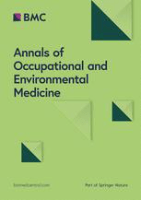
Annals of Occupational and Environmental Medicine
Exploring the Intersection of Work and Well-BeingAnnals of Occupational and Environmental Medicine is a premier open-access journal dedicated to the interdisciplinary study of occupational and environmental health, published by the Korean Society for Occupational & Environmental Medicine. Since its inception in 2013, this journal has become a key platform for researchers, professionals, and students alike to disseminate findings that contribute to the understanding and improvement of health in the workplace and surrounding environments. With an ISSN of 2052-4374 and ranked in the Q3 category (2023) in Public Health, this journal emphasizes innovative research and evidence-based practices in the field. Insights from the Scopus ranking, placing it at #428 out of 665 in its category, highlight its growing impact, despite being positioned in the 35th percentile. Its open-access model ensures that valuable knowledge is readily available, fostering collaboration and progression towards healthier work and living conditions globally. With an ambitious convergence of research spanning from 2014 to 2024, the journal stands as an essential resource for those committed to advancing occupational and environmental health.

International Maritime Health
Navigating the Future of Maritime HealthInternational Maritime Health is a distinguished, open-access journal published by VIA MEDICA that has been pivotal in disseminating research related to maritime health since its inception in 1999. With an ISSN of 1641-9251 and an E-ISSN of 2081-3252, the journal focuses on various aspects of Infectious Diseases, Medicine, and Public Health, making significant contributions to environmental and occupational health, particularly in maritime contexts. As of 2023, it enjoys a Q3 ranking in prominent categories, highlighting its relevance and impact in the field, supported by Scopus ranking that places it competitively within its domains. Open access since 2005, International Maritime Health provides researchers, professionals, and students vital resources to understand and tackle health challenges faced in maritime environments, facilitating the exchange of knowledge that is crucial for enhancing health outcomes in this unique sector. The journal is based in Gdansk, Poland, emphasizing its global outreach and commitment to addressing maritime health issues.